

UNWTO/GTERC Report: Asia and the Pacific grows in importance for Global Tourism
The World Tourism Organization (UNWTO), in partnership with the Global Tourism Economy Research Centre (GTERC), presented its Asia Tourism Trends Report today at the Global Tourism Economy Forum in Macao (China). The report shows Asia and the Pacific outperforming all world regions in growth in international arrivals since 2005.
‘UNWTO/GTERC Asia Tourism Trends – 2018’ shows that international tourist arrivals in Asia and the Pacific grew 6% in 2017 to reach 323 million, around a quarter of the world’s total. Of all world regions, Asia and the Pacific, the second-most visited after Europe, has grown the fastest in international tourist arrivals since 2005. Arrivals increased an average of 6% per year, above the world average of 4%.
Rapid economic growth in a region with over half the world’s population, coupled with rising air connectivity, travel facilitation and large infrastructure projects, have boosted international travel in the region. This has had a large impact on Asian destinations’ tourism earnings, which have steadily increased from 17% of the world total in 2000 to 29% in 2017. This is equivalent to US$ 390 billion in tourism receipts.
Asia and the Pacific plays a vital role as a source market as well, fuelling much growth in both regional and long-haul destinations. The region produced 335 million international travellers spending US$ 502 billion in 2017, 37% of the world total. Around 80% of these visits were concentrated in Asia destinations. Outside the region, 56% of the long-haul trips were to Europe.
EU-China Tourism Year
To celebrate the EU-China Tourism Year 2018, the report looks at international tourism between China, the largest economy in Asia, and the block of 28 European Union (EU) countries.
It finds that 5.7 million Chinese tourists travelled to Europe in 2016, of which 3.5 million went to the EU. In reverse, 5.5 million Europeans travelled to China in 2016, 3.1 million of whom from EU countries.
China’s Greater Bay Area – a major outbound area
The last chapter of ‘UNWTO/GTERC Asia Tourism Trends – 2018’ provides an insight into the Greater Bay Area of China, a project to create a large socio-economic zone and tourism area comprising the two Special Administrative Regions of Hong Kong and Macao, as well as nine cities in Guangdong Province. According to the report, the Greater Bay Area is China’s fastest-growing tourism region and the Pearl River Delta home to several cities with high tourism development including Guangzhou, Shenzhen, Zhuhai and Foshan.
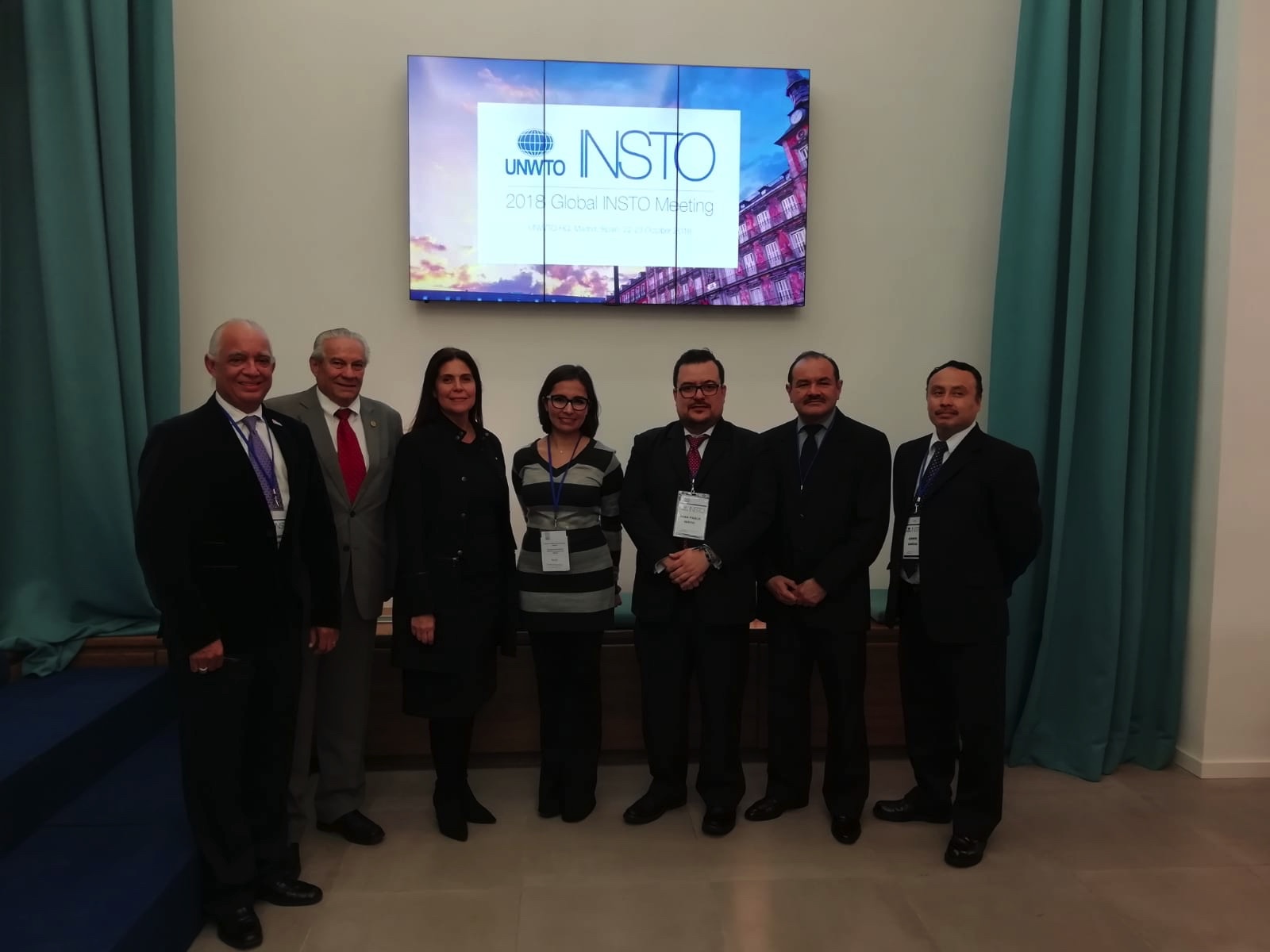
Spatial Data the Focus of UNWTO Sustainable Tourism Observatories Meeting
The World Tourism Organization’s (UNWTO) International Network of Sustainable Tourism Observatories (INSTO) concluded its global annual meeting today in Madrid, welcoming observatories and other tourism stakeholders to share experiences of measuring and monitoring the impact tourism has on destinations, and explore the opportunities provided to tourism by innovation in location services.
With a revamped structure featuring a mentoring breakfast, discussion rounds and workshops, this year’s Global INSTO Meeting focused on offering participants opportunities for interaction. Tourism stakeholders exchanged knowledge on achievements and challenges in measuring social, environmental and economic tourism impacts at destinations. In keeping with UNWTO’s priority of promoting technological innovation that fosters sustainable tourism, attendees took part in three workshops on the potential of geo-referenced information for destination planning.
Guests saw live demonstrations of spatial analysis, brainstormed project ideas using satellite images and learned how to build data dashboards. Such advances in location intelligence can support destinations create more transparent and timely communication and decision-making. The workshops were co-led by the destinations South Tyrol (Italy), Buenos Aires (Argentina) and Portugal in cooperation with private and public sector partners ESRi Spain, SEGITTUR and Vizzuality.
The 2018 Global INSTO Meeting also accepted two new observatories to the network – Panama City, Panama and South Tyrol, Italy – taking INSTO’s membership to 24. “Installing a project of this magnitude will allow us to continually measure the effects of tourism in a particular destination or region. We welcome this initiative with great enthusiasm considering the benefits that the entire tourism sector will receive in the short- and medium-term, and its positive impact on many other economic activities,” said Gustavo Him, Minister of Tourism of Panama, on joining INSTO.
“The decision to join the international observatory network brings with it the responsibility to shape South Tyrol’s development according to sustainability principles. For some years, South Tyrol has been establishing itself as a green region. We see this as another important step in that direction and recognize the value of sharing progress with other pioneer destinations,” said Arno Kompatscher, Governor of South Tyrol.

Dr. Taleb Rifai invites to International Tourism and Investment Conference
Africa is on the mind of two events on the sideline of the upcoming World Travel Market in London next month.
Dr. Taleb Rifai, Chairman of ITIC Advisory Board and Former Secretary-General, UNWTO invites to a special launch event of the International Tourism and Investment Conference (ITIC) and its Tourism Investment Platform. It will be held in London on Friday, 02 November 2018 at the InterContinental Park Lane, Mayfair, from 17:00 – 20:30.
Anita Mendiratta, Founder & CEO of Cachet Consulting & Lead Consultant for CNN will be the moderator.
The African Tourism Board Initiative is inviting their supporters and anyone interesting in bringing African Tourism together to their soft launch event sponsored by Reed Exhibition on Monday, 05 November 2018 at Excel London during the World Travel Market in North Gallery Room 4, 14.00h.
Juergen Steinmetz, publisher of eTurboNews and Chairman of the International Coalition of Tourism Partners will be the master of ceremony for the African Tourism Board Initiative event.
ITIC is designed to serve as a unique global investment platform that will bring together Investors, Private Equity Firms, Bankers, Family Offices, Law firms, Technology Expert alongside Tourism Policy Makers and Ministers, Experts, CEOs of public and private, sector tourism entities as one tourism-focused business community to unlock opportunities for tourism countries strongly reliant on tourism as a foundation for national growth and development.
The Launch Event for ITIC will feature a high-level, professionally facilitated Panel Discussion – Invest Tourism, featuring carefully selected international leaders in tourism and investment with rich insight into opportunities for tourism and investment partnership.
Supporters & Sponsors:
* African Tourism Board
* Intercontinental London
* Daiichi
* WTTC
* Hyda & Reed
* SKAL
Media Partners:
* eTurboNews
* Jacobs Media Group
* TravelWeekly
* American Banker
* African Business
* New African
* New African Woman
Panelists
▪ Honorable Najib Balala, Cabinet Secretary, Ministry of Tourism and Wildlife-Kenya
▪ Honourable Edmund Bartlett, Minister of Tourism-Jamaica
▪ Mr. Gerald Lawless, Former President and CEO of the Jumeirah Group
▪ Mr. Saleh Said, Managing Director of Pennyroyal Ltd, promoter of a tourism village in Zanzibar
Registration and participation at both events are free.
– To register for the ITIC Launch event click here and use password ITIC2018
– To register for the ATB event at WTM click here

WTTC: Shanghai is largest tourism market in the world
Today, the World Travel & Tourism Council (WTTC) released its annual Cities Report at the WTTC Asia Leaders Forum in Macau, SAR. The Report covers 72 of the world’s most important tourism cities, which together generated over $625bn contribution to GDP last year (24.3% of global Travel & Tourism GDP).
The world’s top ten cities in terms of tourism market size are: Shanghai (US$35bn), Beijing ($32.5bn), Paris ($28bn), Orlando ($24.8bn), New York ($24.8bn), Tokyo ($21.7bn), Bangkok ($21.3bn), Mexico City ($19.7bn), Las Vegas ($19.5bn) and Shenzhen ($19bn).
The world’s top ten cities in terms of job creation are: Jakarta, Beijing, Mexico City, Shanghai, Bangkok, Chongqing, Delhi, Mumbai, Ho Chi Minh City, Shenzhen.
WTTC President & CEO Gloria Guevara commented, “With 54% of the world’s population living in urban areas, cities have become global economic hubs, driving growth and innovation. They attract huge quantities of people who travel to experience their culture, do business, and live. This growth has also resulted in a rise in city tourism – a trend which is forecasted to maintain momentum.
“Our Report highlights the crucial importance of cities to Travel & Tourism worldwide, and likewise how vital this sector is to the economy. Over half a billion trips are made to cities annually representing 45% of global international travel.”
Highlights from the Report include:
· Cairo was the fastest growing city in 2017 in terms of Travel & Tourism GDP contribution (34.4%), followed by Macau (14.2%).
· Four of the five fastest growing cities over the past ten years are located in China: Chongqing, Chengdu, Shanghai, Guangzhou.
· Shanghai is ranked as the largest city by Travel & Tourism volume in 2017. By 2027, Shanghai is expected to be double the size of Paris in terms of Travel & Tourism’s direct contribution to GDP.
· Bangkok (50.4%), Paris (29.8%), Mexico City (24.0%) and Tokyo (20.2%) are the biggest contributors to their country’s Travel & Tourism GDP.
· In terms of domestic vs. international spend, New York sets an example as a city with a remarkable balance (52.7% vs. 47.2%). Meanwhile, Paris relies heavily on international spend and Beijing on domestic.
China markets driving growth
Of particular note, Chinese cities have matured rapidly over the past decade, and are forecast to continue dominating the growth charts between 2017 and 2027. Shanghai, for example, went from being the 8th largest city in terms of Travel & Tourism GDP in 2007 to become the largest in 2017 – a position it is expected to maintain until 2027. Meanwhile, the rapid growth of Guangzhou will take it to 4th place, and Chongqing is forecast to join the top 15 for the first time. This comes following a period of sustained infrastructure development, including investments in airports and extensive product development.
The Chinese domestic and outbound markets will drive growth in the coming decade, with the majority of top performers maintaining their positions. Chinese cities will continue to lead, although a slowdown in growth is expected. With the exception of Marrakech, the cities in the top ten ranking of fastest growing Travel & Tourism GDP in the coming decade are in Asia-Pacific.
Guevara continued, “With such good performance of cities around the world, and the supreme growth experienced by cities in Travel & Tourism, comes huge opportunities. This Report illustrates the strength of Travel & Tourism and its economic impact not only at a macro-level but at the grassroots where it is relied upon every day. A vibrant tourism sector can stimulate investment, preserve and promote cultural heritage, and catalyse new activities such as research, technology or the creative economy.
“Planning for and managing growth so that it is inclusive and sustainable – with the well-being of the communities who live and work in such cities at its core – needs to be the top priority for city governments, working in partnership with the private sector.”
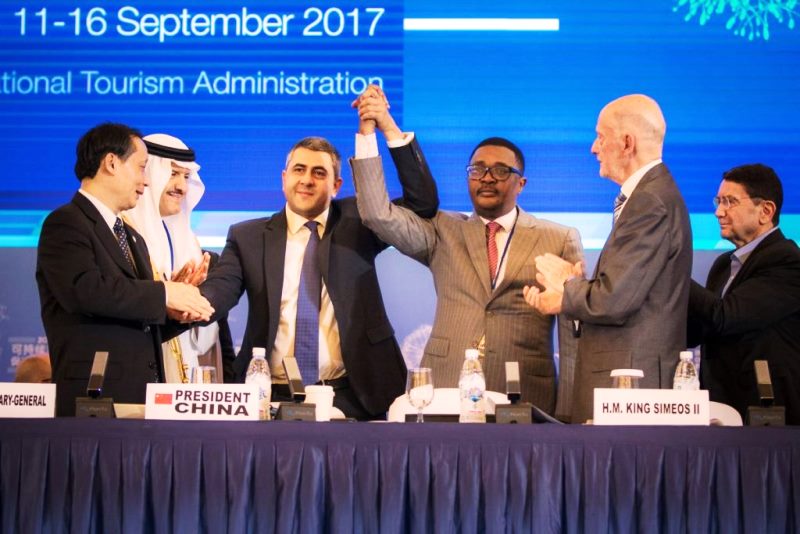
Battling Cancer and let down by World Tourism
What happened to Dr. Walter Mzembi, former minister of Tourism and Hospitality for Zimbabwe, and former candidate for UNWTO Secretary-General? Dr. Mzembi is currently getting medical treatment battling cancer in South Africa and is frustrated. He is trying to understand where the African tourism family is when one of its own is being persecuted?
There are many indications Dr. Mzembi is being harassed while we all watch.
They have persecuted him for nearly a year now, on some incomprehensible criminal charges brought up by the new government in Zimbabwe.
Such charges touch on the integrity of the UNWTO itself. It’s a seemingly sophisticated witch hunt meant to discredit his legacy with the UNWTO, where he with distinction led the Commission for Africa from 2013 to 2017 for two consecutive terms.
Mzembi set the agenda for continental tourism policy formulation. His successor Najib Balala, minister of tourism from Kenya acknowledged his legacy at the last UNWTO Commission of Africa Meeting in which Africa reaffirmed its support for his candidature for the post of UNWTO Secretary-General position.
Dr. Mzembi honorably lost this election by a two-country margin on behalf of Africa. Where is Africa when one of its own is being persecuted
 The prosecution or better persecution of such a distinguished African citizen is a negative exercise for global tourism, it’s negative for Africa and specifically Zimbabwe.
The prosecution or better persecution of such a distinguished African citizen is a negative exercise for global tourism, it’s negative for Africa and specifically Zimbabwe.
Dr. Mzembi is a resource that any Government and Africa should exploit to its advantage.
How do you reconcile this with the way the new dispensation in Zimbabwe is treating Walter Mzembi?
Did they forgot his work co-hosting the 20th session UNWTO General Assembly at Victoria Falls in what was described by then Secretary-General Taleb Rifai as the “best ever and most attended General Assembly in the history of General Assemblies”
Walter Mzembi brought the global tourism family attending the UNWTO General Assembly in Chengdu, China to a five-hour gridlock insisting on the procedure on the affirmation of the new Secretary General. It ended with him compromising and giving his concession speech din with humility he congratulating his rival, the current UNWTO Secretary-General Zurab Pololikashvili.
Former Minister Mzembi and for a decade steered Zimbabwe through the most difficult period and got many endorsements for his country. He has been seen as a true patriot that it makes us wonder why such good deeds could be so easily forgotten on the expediency of a new dispensation in Zimbabwe.

Perhaps Dr. Mzembi has a point when he asked eTurboNews: “Where is the international tourism family when one of its own is being persecuted?”
Click here to read the letter of acknowledgment by the Zimbabwe government
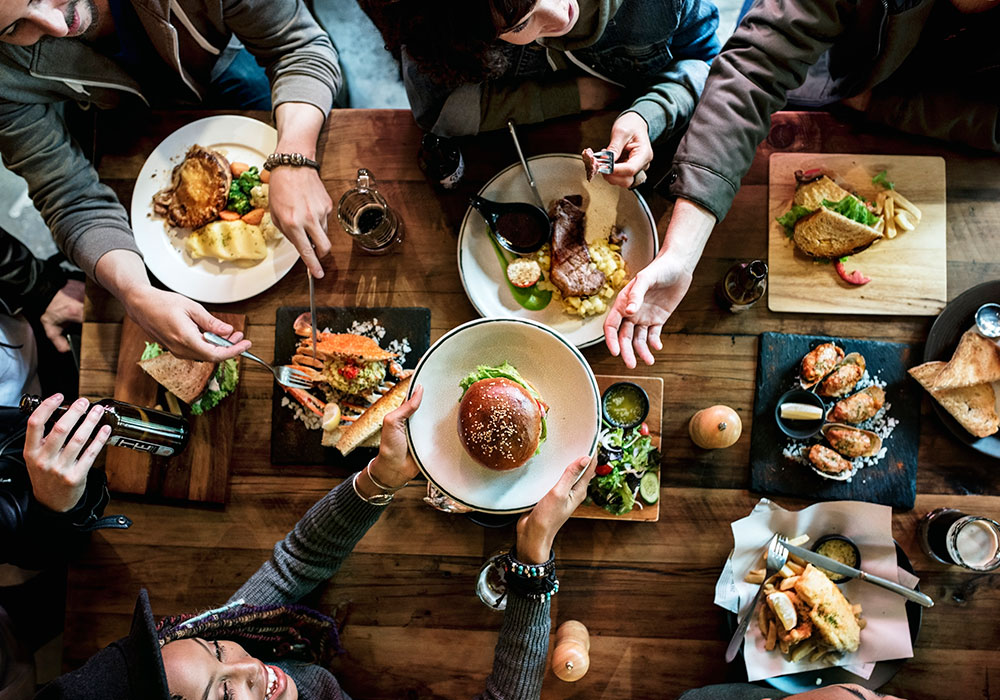
First global Gastronomy Tourism Startup Competition launched
The World Tourism Organization and Basque Culinary Center (BCC), have launched a pioneering initiative for the gastronomic tourism sector, with a global call for startups or companies, mature or emerging, technological and non-technological, with innovative ideas capable of revolutionizing and integrating gastronomy in tourism and inspiring tourists with new ways and reasons to travel.
The gastronomic tourism sector is moving towards innovation and the diversification of its offerings. UNWTO, in collaboration with its Affiliated Member, Basque Culinary Center (BCC), has launched the 1st UNWTO Gastronomy Tourism Startup Competition, the first and largest initiative in the world dedicated to identifying new companies that will lead the transformation of the gastronomic tourism sector.
Intangible cultural heritage has become the decisive factor that attracts and captivates tourists. Gastronomy tourism, as a component and vehicle of culture and tradition, is an indispensable resource that adds value and provides solutions for destinations that seek to stand out through unique product offerings.
The Competition will make it possible to identify the best solutions and projects that contribute the most to the sector through pioneering proposals in the implementation of emerging and disruptive technologies, as well as emerging companies or startups. It aims to identify challenges and projects, and to catalyse innovations that can transform the Gastronomy Tourism sector in the near future.
“Innovation and tourism investments are not ends in themselves, but are means to promote better tourism products, improve tourism governance and harness its proven capability to foster sustainability, create jobs and generate opportunities,” said UNWTO Secretary-General, Zurab Pololikashvili.
“Education and innovation are essential for the development of sustainable gastronomic tourism. At Basque Culinary Center, we support entrepreneurship and the development of new business projects to ensure the future of the sector. In this regard, we are proud to once again team up with our partners at UNWTO in order to continue fostering entrepreneurship and innovation linked to gastronomy tourism through this initiative,” said Joxe Mari Aizega, General Manager of Basque Culinary Center.
UNWTO and Basque Culinary Center have entrusted the process of finding startups to BCC Innovation through its Culinary Action! programme, which has accelerated nearly 50 startups by providing innovative, sustainable and high added value solutions to the gastronomy value chain.
Sustainability and technology
Startups are invited to pitch business models that are related to sustainability, respect the value chain, offer an authentic and coherent narrative, and add value to cultural and local heritage.
The winners of this competition will have the opportunity to present their projects at the 5th World Forum on Gastronomy Tourism (2-3 May 2019, San Sebastián, Spain), with the possibility of receiving personalized consulting and mentoring from the BCC experts of project accelerator Culinary Action!
Full information on the terms and conditions are available here.
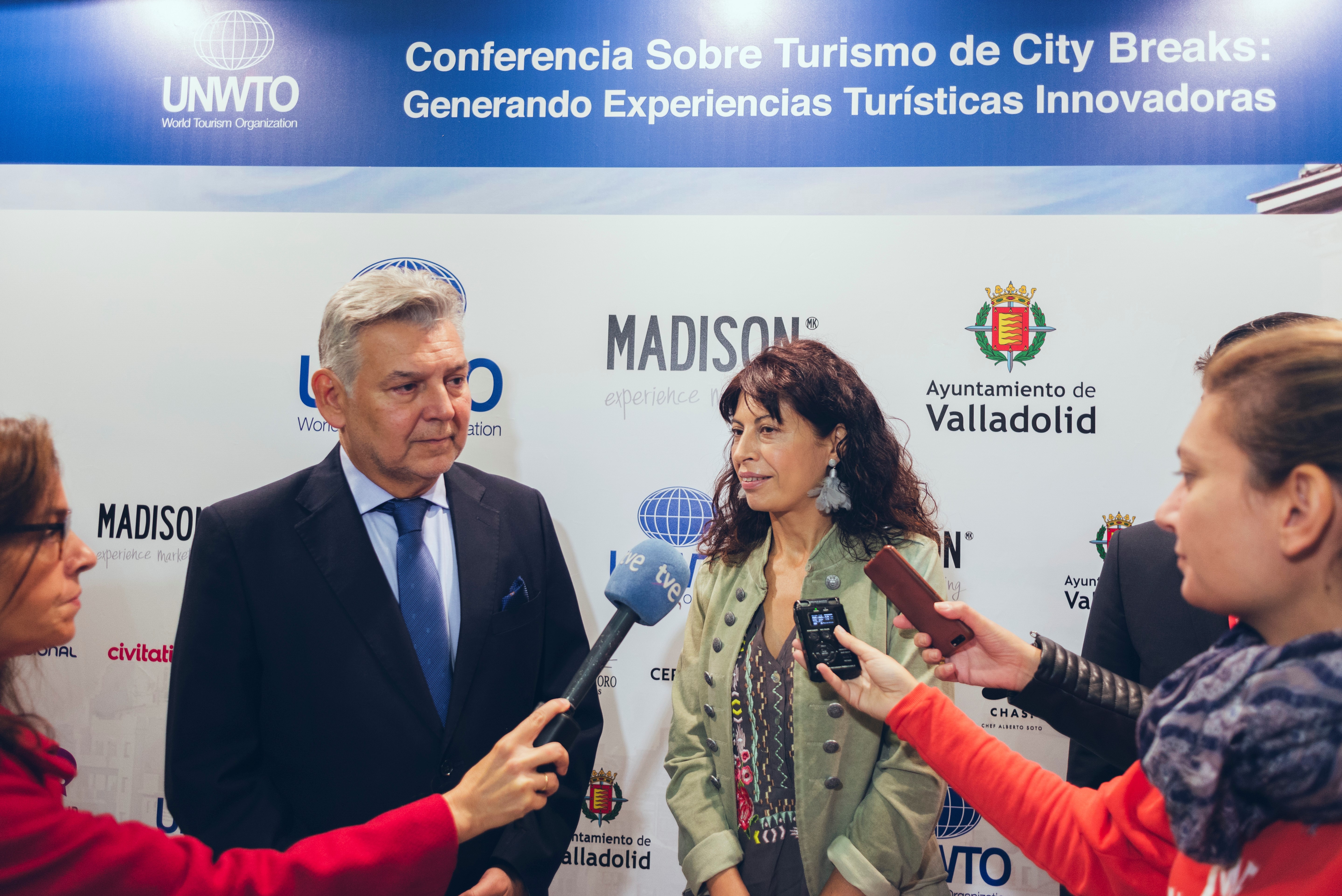
Creating Smart Cities for Innovative Tourism Experiences
The UNWTO Conference on City Breaks: Creating Innovative Tourism Experiences (15-16 October 2018) concluded today in Valladolid, Spain, with a call for cities to become smart tourism destinations, where tourism governance and the digital economy mesh together to offer travellers diverse and authentic experiences.
The conference brought together tourism leaders from the public and private sectors to analyse how to respond to the growing trend of city breaks as leisure experiences. They concluded that public-private partnerships, the inclusion of local communities and the creation of smart destinations are crucial for urban destinations to gain the knowledge and define the policies they need in order to respond to the new demands of hyper-connected and hyper-informed tourists.
“We must understand the evolution of tourists towards greater sustainability and inclusiveness, using new technological tools,” said Jaime Cabal, Deputy Secretary-General of the World Tourism Organization (UNWTO). “Creativity and innovation are needed when designing the experiences they are increasingly demanding.”
The Councillor for Culture and Tourism of Valladolid, Ana Maria Redondo, echoed this call, adding: “We need a better understanding of the fundamentals behind the current demand for city break experiences. Smart destination tools are our means to obtain this knowledge.”
The Deputy Director-General for Tourism Development and Sustainability of the Ministry of Tourism of Spain, Ruben Lopez Pulido, suggested that cities and all destinations change their models of tourism development to respond not only the most demanding tourists, but also to the rise of the digital and knowledge economy. “Being a smart destination is not just a label, but a process towards the comprehensive transformation of destinations, while always aiming at the achievement of the Sustainable Development Goals,” he said.
Speakers at the conference included Dieter Hardt-Stremayr, President of European Cities Marketing and CEO of the Graz Tourism Office in Austria, who described what he considered key challenges for the growth of city breaks: transportation issues, seasonality, and the dispersion of tourism demand within a city and over time. “Our main challenge is to attract visitors to come right at this moment. To overcome it destination managers should focus on parts of the tourism offer that are ‘temporary’,” he concluded.
The main conclusions of the conference referred to urban tourism governance models. Participants highlighted that, with the growth of high-speed, low-cost transportation links that provide more and more visitors with access to city breaks, city destinations must respond by prioritizing investments that benefit residents and tourists alike.
They also concluded that with the technological advances that allow the creation of smart destinations, destination management organizations must shift their focus from only promoting the experiences available for tourists in cities, to managing urban tourism in all its complexity. For their part, tourism policy makers should use smart destination tools to study the impact of tourism on the profitability and sustainability of a city, and place the destination at the centre of policy changes. These conclusions will be taken into account in the UNWTO work plan on urban tourism.
The Conference was organized by the UNWTO in collaboration with the City Council of Valladolid and the marketing agency MADISON, an Affiliate Member of the UNWTO. Other speakers included representatives from Madrid Destino, San Sebastián Turismo & Convention Bureau, Ljubljana Tourist Board, Turin Convention Bureau, Lisbon Tourism Observatory, Municipality of Alba lulia (Romania), Google, TripAdvisor, Basque Culinary Center, World Heritage Cities of Spain, AMFHORT, European Historical Association of Thermal Cities, Innova Tax Free, Thyssen-Bornemisza Museum, Thinking Heads, Segittur, Civitatis, Authenticitys and Amadeus, as well as journalists Xavier Canalis of Hosteltur and Paco Nadal of El Viajero (El País newspaper).
International arrivals into Asia Pacific continue to exceed the global average
Foreign arrivals into Asia Pacific destinations continued to grow at better than the global average in 2017, reaching a record volume high of more than 646 million arrivals relative to 2016.
According to the Annual Travel Monitor 2018 Final Edition (ATM) released by the Pacific Asia Travel Association (PATA) today, international visitor arrivals (IVAs) into 47 destinations in Asia Pacific covered in this report increased by 5.7 percent and added close to 35 million additional arrivals to the collective foreign inbound count into Asia Pacific in 2017.
In percentage increase terms between 2016 and 2017, the Pacific had the strongest annual increase at 5.9% year-on-year, followed by the Americas at 5.8%, while Asia kept pace with the Asia Pacific average of 5.7%.
By annual increase in the absolute volume of foreign arrivals however, these positions were reversed with Asia receiving close to 25 million additional foreign arrivals between 2016 and 2017, followed by the Americas with a gain of almost 8.6 million and the Pacific with around 1.4 million additional foreign arrivals received over that period.
Within the Americas, Central America showed the strongest incremental increase in foreign arrivals between 2016 and 2017, capturing 50.5% of the 8.577 million increase into the Americas over that period.
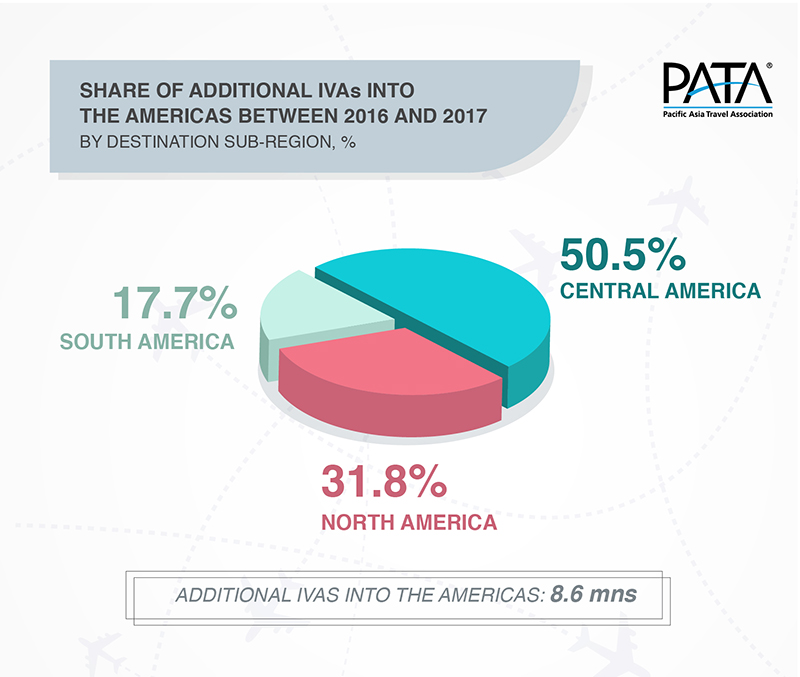
Across Asia it was Southeast and West Asia that each captured the largest proportion of additional foreign arrivals into Asia between 2016 and 2017.
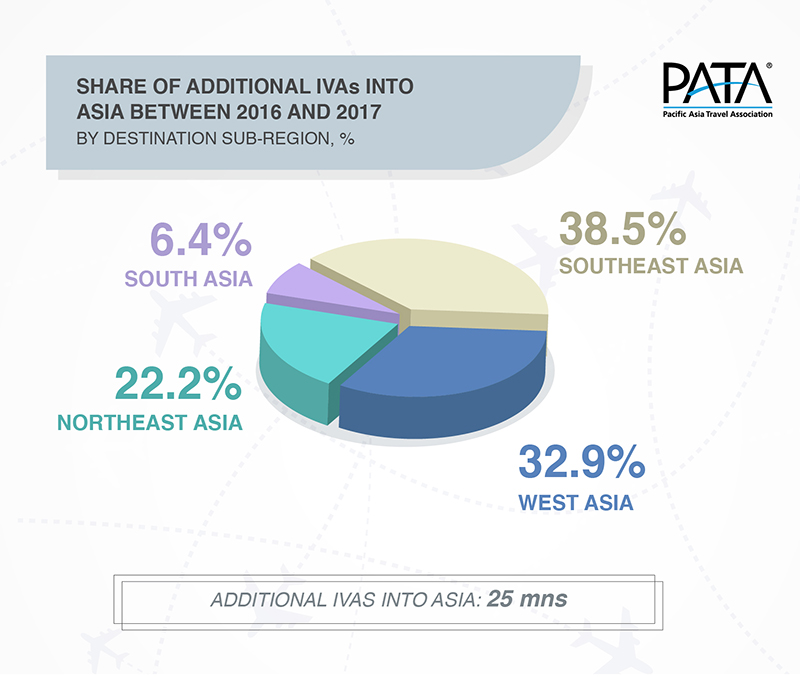
While in the Pacific, Oceania received more than half of the additional foreign arrivals into the region, followed by Polynesia.
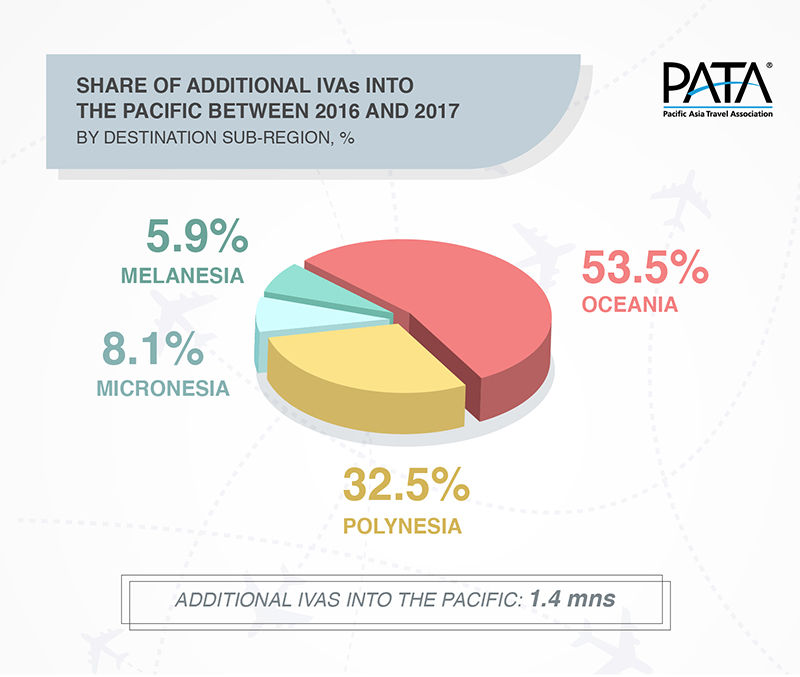
At the individual Asia Pacific destination level, destinations with the strongest annual percentage growth rates in 2017 ranked as:
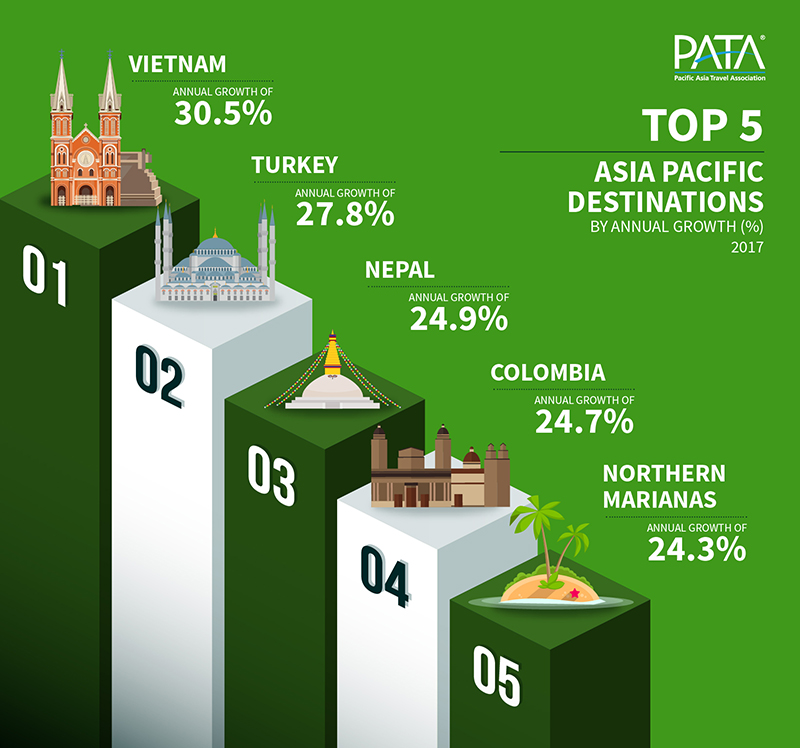
All told more than 40% of the 47 destinations covered in this report had annual growth rates in excess of 10%; another 28% had annual growth rates in excess of five percent.
For sheer annual volume increase between 2016 and 2017, the strongest Asia Pacific performers were ranked as:
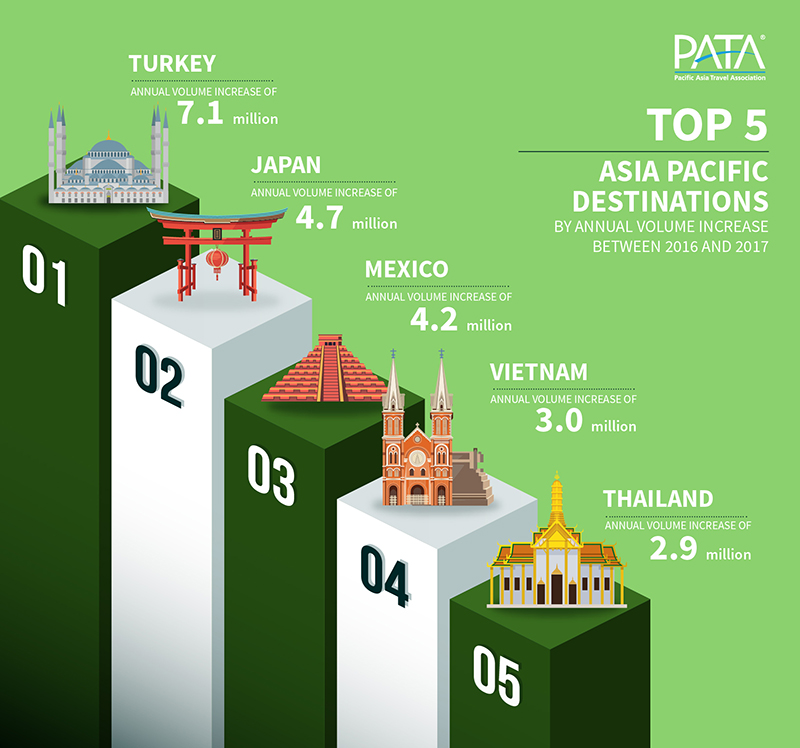
Of the destinations covered in this report, more than a quarter had annual volume increases of more than one million each, while close to 15% had between half a million and one million apiece.
The strong collective performance of Asia Pacific destinations in 2017 appears to be continuing into 2018 as well. As Dr. Mario Hardy, the CEO of PATA pointed out, “Early results for 2018 show a collective annual increase in foreign arrivals into Asia Pacific destinations of 8.7%, adding more than 25 million additional arrivals to the total inbound count during the first periods of 2018 relative to the same period of last year.”
Thirty-six Asia Pacific destinations had released year-to-date 2018 data on foreign arrivals at the time of preparing the Annual Tourism Monitor for 2018 and these are covered in some detail through the body of the report.
The strongest early performances are seen in a number of destinations including:
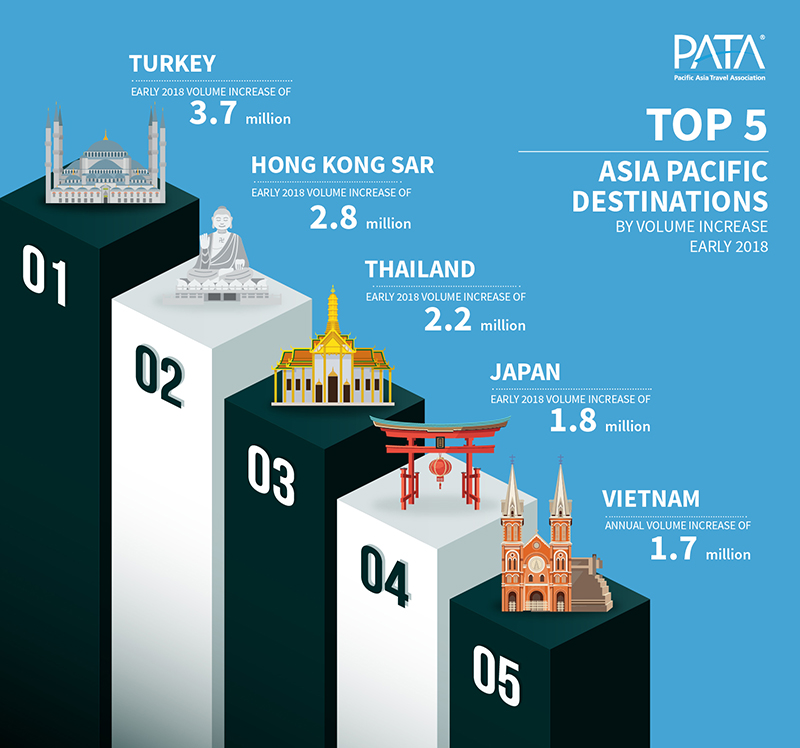
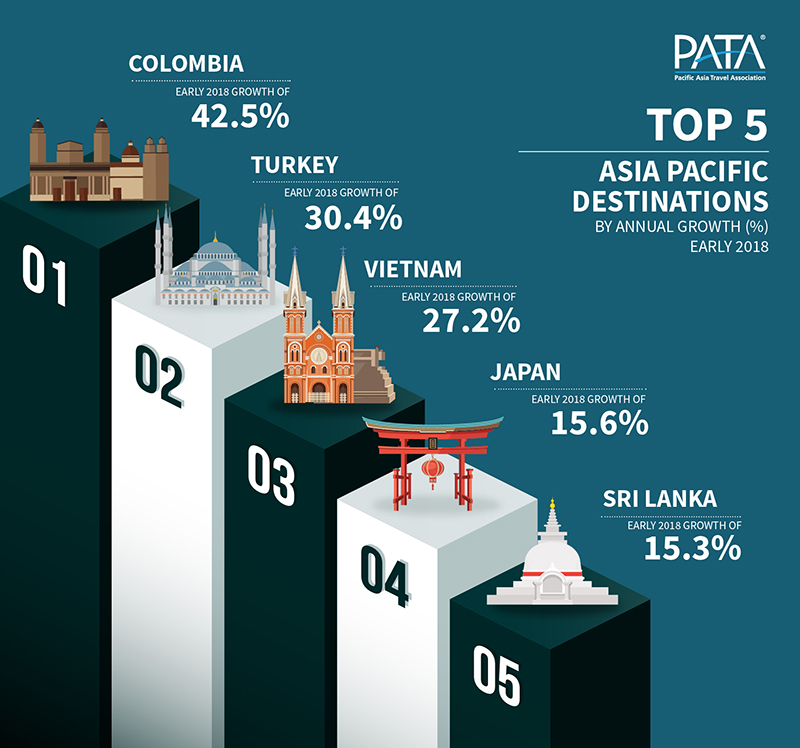
Furthermore, one quarter of these destinations had already posted volume increases of more than one million foreign arrivals in early 2018, relative to the same periods of 2017. Included amongst these are:
“In general terms, the volume of foreign arrivals into most Asia Pacific destinations now needs to be managed in terms of distribution across the destination, especially with growth rates remaining relatively high,” adds Dr. Hardy. “This includes shifting our focus from just the volume of arrivals to other performance metrics including length of stay and yield as primary indicators, along with developing a better and deeper understanding impacts of tourism on the environment and society at all levels, especially if we as a responsible economic sector wish to remain sustainable and therefore viable into the future.”
“It is not only the international travel flows that have an impact either. The domestic demand for new travel experiences is gathering momentum in many destinations as well, and when coupled with international visitor flows, that creates a very powerful dynamic. It is incumbent on us all to ensure that we can properly harness and manage that power or else risk losing those very attributes that drive visitor interest in the first place.”
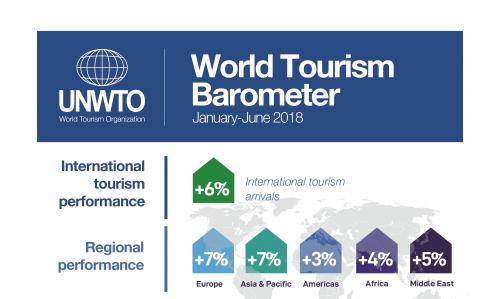
International Tourism Maintains Strong Momentum
According to the World Tourism Organization (UNWTO)’s latest barometer, international tourist arrivals grew 6% in the first six months of 2018 after a record year of growth in 2017.
All world regions enjoyed robust growth in tourist arrivals in January-June 2018. The increase was fuelled by strong demand from major source markets, supported by an upswing in the global economy. It comes after record year-round growth of 7% in 2017.
“Today’s release of international tourism data for the first half of 2018 serves as further proof of the sector’s resilience and relentless growth trajectory. We continue to work with our many partners to translate this growth into better jobs, more benefits to societies, and more opportunities for sustainable livelihoods and destinations”, said UNWTO Secretary-General Zurab Pololikashvili.
By region, Europe and Asia and the Pacific led growth with a 7% increase in arrivals each. Southern Mediterranean Europe and South-East Asia had the strongest results in these regions, both welcoming 9% more international tourists.
The Middle East and Africa also recorded sound results with arrivals growing at 5% and 4%, respectively, according to still-limited information available for destinations in these regions. The Americas saw 3% growth in arrivals over the six-month period, driven by South America (+7%) and North America (+5%). The United States continued to fuel much growth in the region and beyond.
On the demand side, France, the United Kingdom and the Russian Federation all reported double-digit increases in outbound spending in Europe. India and the Republic of Korea drove growth in Asia and the Pacific, while the world’s top source market China reported similar spending as in the same period last year.
Looking ahead
The first half of the year accounts for about 45% of annual international tourist arrivals. The second half represents 55% as it is three days longer and includes the Northern Hemisphere high-season months of July and August.
Against a strong first semester, growth prospects for the remainder of 2018 remain positive overall, though at a slower pace, according to the latest UNWTO Confidence Index survey. The Index value for May-August and expectations for September-December are somewhat lower than the Index value for January-April.
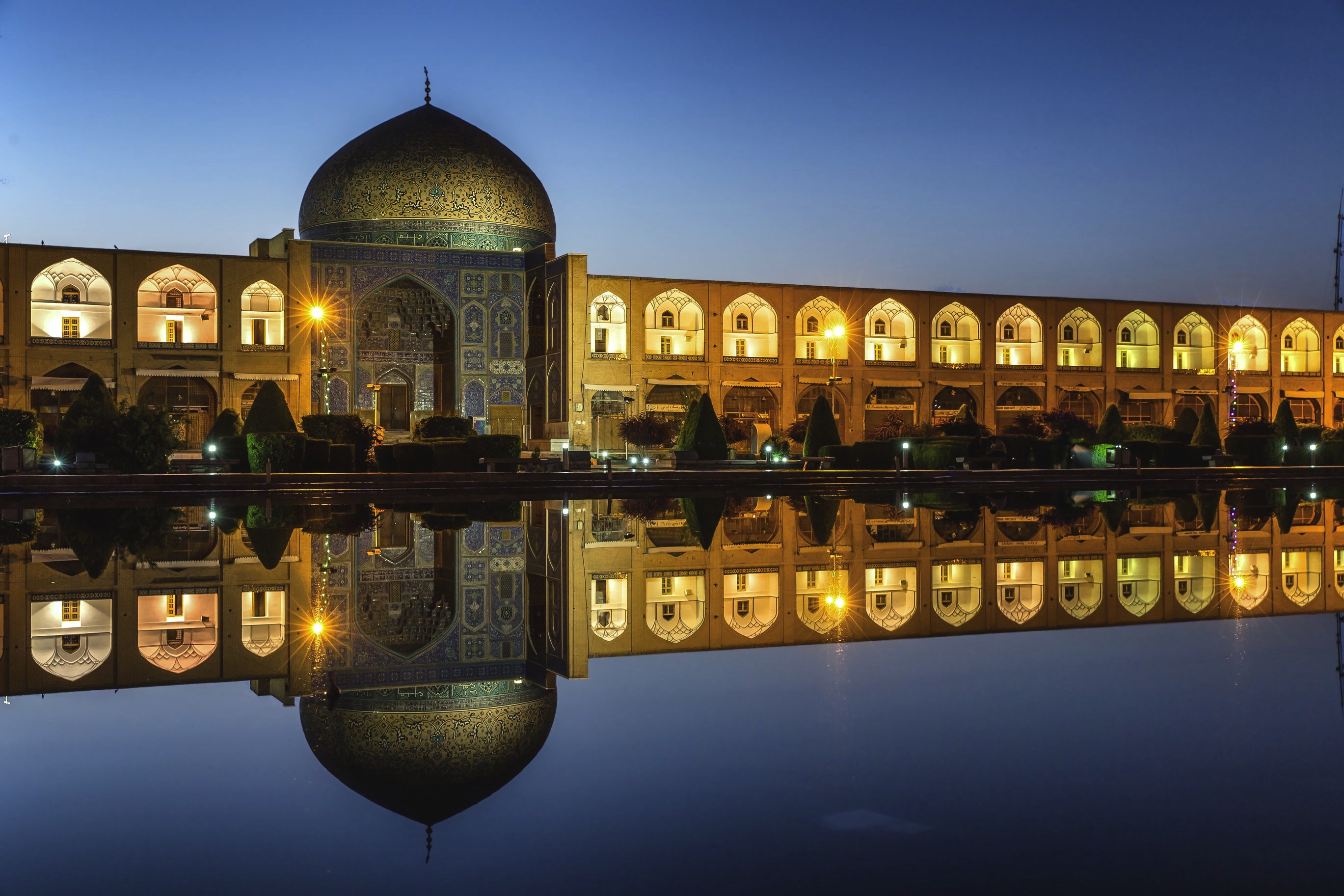
Technology and Innovation Seen as a Big Boost to Cultural Tourism
Seeking to advance use of innovation and cutting-edge technologies into cultural tourism practices, destinations and products, the International Seminar on Harnessing Cultural Tourism through Innovation and Technology will be held in Hamedan, Iran alongside the 40th UNWTO Affiliate Members Plenary Session (12-14 November 2018).
The seminar recognizes the significance of innovation in managing and promoting cultural tourism, which is one of the largest global tourism markets, and the opportunities of integrating innovative governance into the management of cultural tourism destinations. Through disrupting the sector and creating opportunities for improving governance, competitiveness and cultural resource preservation, innovation and technology are instrumental in enhancing cultural tourism development.
The seminar will feature three panels, exploring how big data, innovative business models, digital services and marketing, and other new technology can ensure long-term sustainability, profitability and competitiveness for cultural tourism products while preserving their authenticity. The keynote panel will explore how innovation and technology generate new opportunities for, and motivate new players to enter, the cultural tourism sector.
An estimated 4 out of 10 tourists choose their destination based on its cultural offering. The conference will explore how this choice is increasingly motivated by intangible factors such as a place’s culture, history, traditions and atmosphere, or its association with famous people, ideas or events.
Host city Hamedan, historically home to Iran’s famous scientists and poets, is nowadays known for its rich heritage of handicrafts, namely pottery design. The small town of Lalejin in Hamedan Province was designated the World Pottery Capital by the World Crafts Council on July 2016. Nearby Alisadr, the world’s largest water cave, is another renowned tourist attraction.
The seminar, which also spans the UNWTO Affiliate Members’ 40th plenary, is jointly organized by the World Tourism Organization (UNWTO), the Iran Cultural Heritage, Handcraft and Tourism Organization, and Alisadr Tourism Company.
